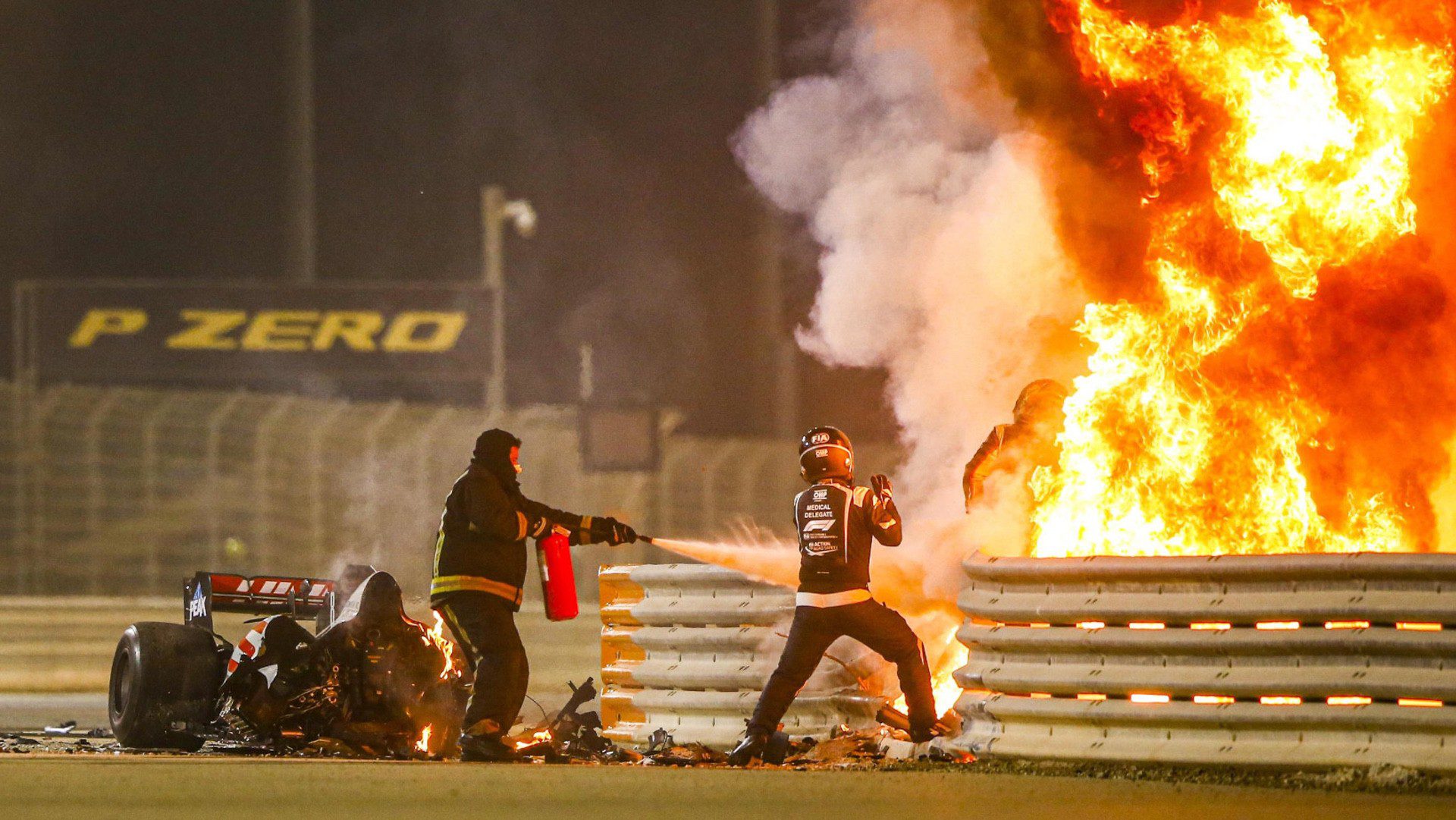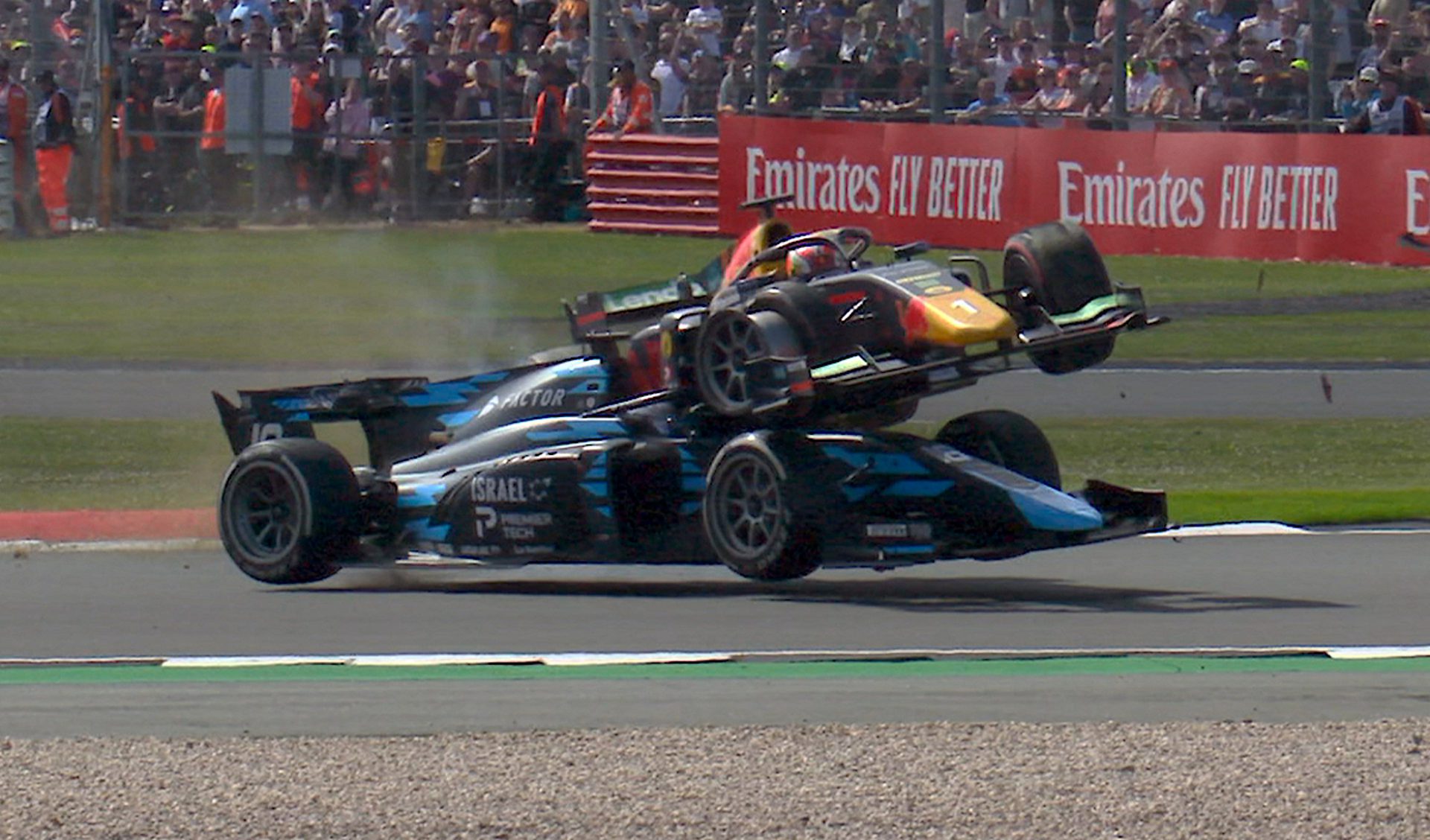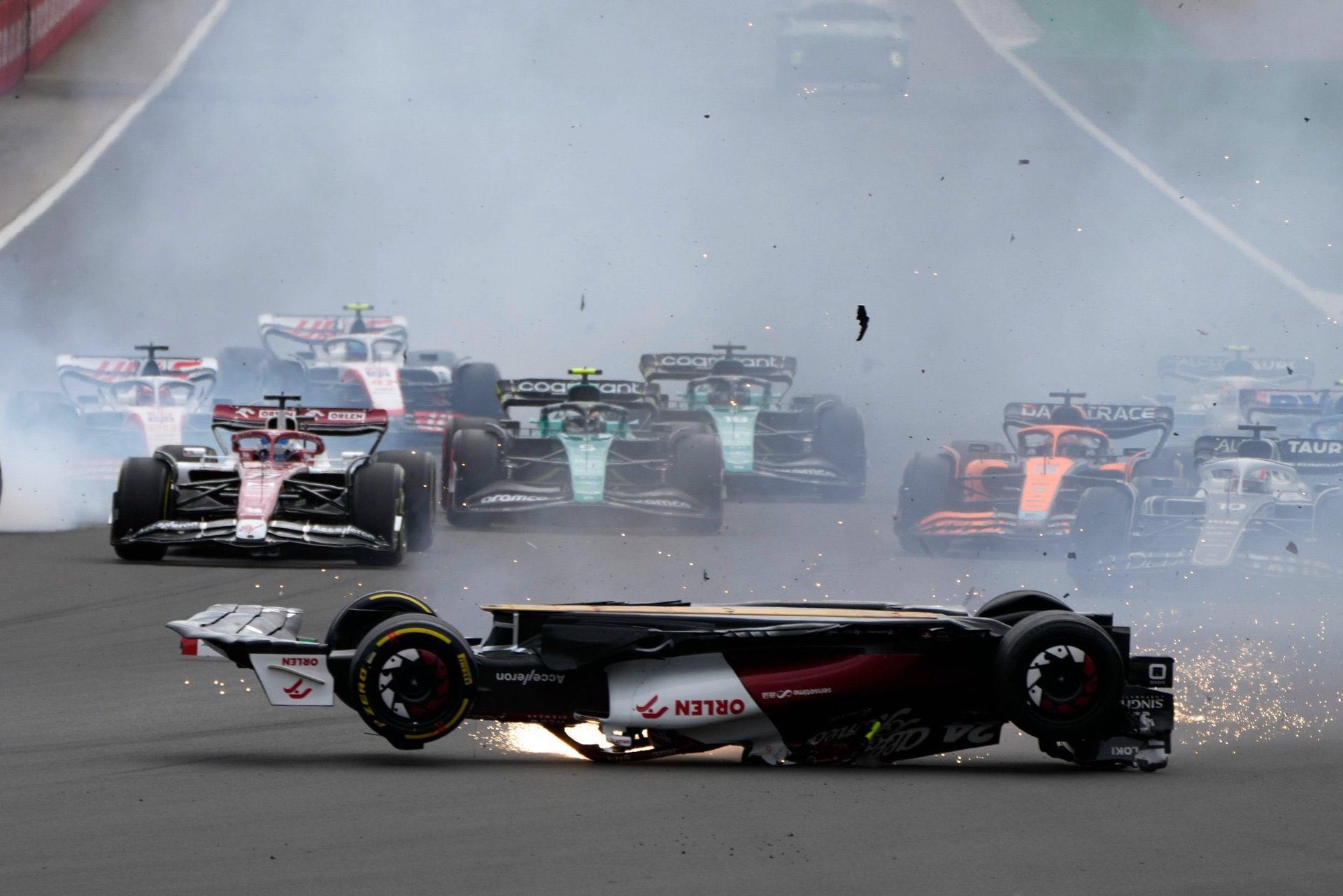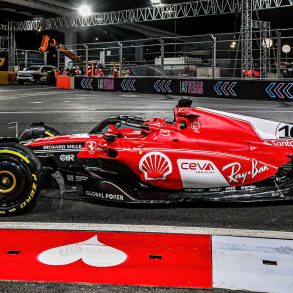For those of us that have been watching Formula One races since the early 1990s, the safety advances that have been implemented in the last 30 years are extraordinary. Consider that the first carbon fiber chassis cars were just starting to be developed around the late 1980s, and the material was so thin you could quite literally punch a hole in it with your hand if you hit it the right way. Nowadays, the chassis of the car is built around a carbon fiber, foam, and aluminum honeycomb structure known as the safety cell, which can take extreme impacts from almost every angle and maintain rigidity.
Despite the mandatory safety cell, wheel tethers, the HANS device for drivers, better fireproofing, and fire-resistant drivers suits, the one area that remained exposed at all times was the driver’s head. Helmet technology has come along in leaps and bounds, and after Felipe Massa took an errant suspension spring over his left eye at the 2009 Spanish Grand Prix, they were completely reworked to be even safer. Yet the head was still exposed, as it was a “core piece” of open-wheeled formula racing.
This steadfast adherence to open cockpit racing would, unfortunately, have tragic consequences. At the Japanese Grand Prix in October 2014, popular French driver Jules Bianchi, when entering a double-yellow flag zone, meaning to slow down and be prepared to stop if needed, lost control of his Marussia F1 car as another car was being removed from where it had crashed by a recovery tractor.
Bianchi’s car hydroplaned off the road and slid with unabated speed across the grass until it struck the back of the recovery tractor, with the safety cell of the car pushing the tractor up slightly, so that the solid rear of the engine cover tore off the roll hoop, crushed the left side driver’s head support, and impacted his helmet. From the angle it hit, this caused massive deceleration on multiple axes, severely injuring Bianchi, who died just over half a year later after slipping into a coma he never woke up from.
The Most Important Safety Advancement in Decades
Because of the death of Bianchi, and the subsequent investigation into the chain of events leading to the accident, one of the results was that despite all the advancements of the safety cell, helmets, and the like, head protection was deemed as necessary, no matter how much it would “ruin” the open cockpit aspect of Formula racing.
Millions of dollars were budgeted, and expert engineers from around the world, both in and out of motorsport, were brought in to develop and design a head protection device that would prevent fatal head injuries, while also not impeding the drivers’ vision and being able to be integrated into the current safety cell as well as future ones.
The final result of three years of investigation, testing, experimentation, and more than a few late nights poring over data was the HALO. It consists of a titanium bar, bolted at each end to the roll hoop riser behind the drivers’ head, which passes around and above the drivers’ helmet, with a thin central spar, also made out of titanium, which comes down in front of the driver and bolts directly into a hard-point built into the safety cell tub. This is designed so that it is between the eyes in the field of vision and lets the driver look left and right for cornering.
In the parlance of Formula One, the HALO is a “critical structure,” meaning that like the safety cell it bolts to, it must not fail even in the most extreme circumstances. As such, during development, it was massively over-engineered, to the point that if you dropped a London city bus on the HALO from a height of 10 feet, it wouldn’t even flex.
In terms of actual numbers, a HALO must withstand instant forces of 116 kiloNewtons (kN) from above for five seconds, longitudinal forces of 46 kN for five seconds, and then an increase to 83 kN on the front for five seconds without relieving the first stressing force, plus lateral loads of 93kN for those same five seconds.
This is all despite the development version weighing 7 kg, and the final, mandated version for 2018 weighing in at 9 kg. It was such an important advancement that any open wheel series that were under the auspices of the FIA were mandated to install a version of it on their cars.
Thus, the HALO appeared in the 2018 season on F1, F2, and F3 cars, as well as in Formula E, Formula Regional, and in feeders series such as Formula Toyota in New Zealand, S5000 in Australia, Super Formula and Super Formula Lights in Japan, and EuroFormula Open in Europe.

It was initially heavily criticized, with some drivers calling it an abomination, and future World Champion Max Verstappen declaring that it “abused the DNA” of a Formula car. It wouldn’t be long, however, until many drivers started to see the benefits, as during the 2018 F2 support race at Barcelona-Catalunya in Spain, the HALO prevented a driver from being crushed when another car was launched into the air and landed directly on top of it.
It also came into play at the 2018 Belgian Grand Prix, when Fernando Alonso’s McLaren was launched up and into Charles LeClerc’s Alfa Romeo, where the HALO both kept the McLaren from impacting LeClerc’s head and also deflected a wheel and tire assembly that would have seriously injured or killed LeClerc as the McLaren sailed over the bar.
Perhaps the most dramatic demonstration of the HALO saving a life was at the Bahrain Grand Prix in 2020, when on the first lap, Romain Grosjean’s HAAS F1 car came into accidental contact with Danil Kvyat’s AlphaTauri F1 car, turning the car so that it speared into the guardrail on the side of the track. It hit with such force and velocity that the car pierced the guard rail, sending the safety cell through the barrier before it slammed sideways into a stanchion, which ripped the car in half, causing a fuel spill and a major fire.
However, because of the HALO, the guard rail’s middle section, which would have impacted Grosjean’s head and very possibly decapitated him, was shoved up and over him. He was in the fireball for a grand total of 31 seconds, never lost consciousness despite a 67 g deceleration, and was able to climb out of the safety cell by squeezing between the HALO and the body of the car.

Grosjean’s total injuries were some burns on his hands and on one foot, as he had to abandon one of his racing boots to get out of the car. In the very first interview he gave after the accident, he simply said “without the HALO, I wouldn’t be here.” Other drivers that had been moaning about the HALO were instantly silenced, and accepted that it had, in fact, saved Grosjean’s life.

Recent Life-Saving Examples From the 2022 Silverstone Grand Prix
With the HALO now an accepted and standard part of the Formula series of events sanctioned by the FIA, it has started to be grouped in with safety belts and the HANS device as systems that are just there and are taken for granted. There were, however, two very stark reminders as to just how much the HALO has improved safety during the 2022 Silverstone Grand Prix on the 2nd and 3rd of July.
In the F2 support race, the HALO, without any shadow or mention of doubt, saved the life of Roy Nissani after he nudged points rival Dennis Hauger off the track. Hauger’s car slid across the infield grass, hit a sausage kerb, and was launched into the path of Nissani’s car at head height. The HALO plowed into the sidepod of Hauger’s car and lodged itself into the body, which caused the momentum of Hauger’s car to literally lift the entirety of Nissani’s car into the air.
They both landed in the gravel trap off the side of the course, with Nissani none the worse for wear. Without the HALO, it would have been his head lodged in the sidepod, and one pales to think about what that amount of momentum would do to flesh and bone, if it was enough to lift an entire formula car by a solid titanium structure.

While that crash was serious, all of the safety features worked as intended, and both drivers walked away. A far more severe and dramatic example of the HALO saving a life occurred at the start of the Formula One Grand Prix event.
At the start, Mercedes driver George Russell and Alfa Romeo driver Zhou Guanyu were split by Williams driver Nicholas Latifi, who had a stellar start. AlphaTauri driver Pierre Gasly looked to be following him through, but Russell drifted left to set up for the first right hand corner, making contact with Gasly’s wheel.
That contact pitched Russell hard left, impacting the sidepod of Zhou’s Alfa, which then rode its right rear tire up and over Russell’s left front tire. This pitched the Alfa over to land upside down.

For this very uncommon situation, the cars all have a roll hoop, a piece of shaped titanium that can support the weight of the car. These hoops are tested, however, under static loads, meaning that the force that is applied to them is constant, and not pitching, shifting, or rotating.
When Zhou’s Alfa landed on its roll hoop, it was almost immediately overloaded as the car was spinning like a top as it slid across the tarmac. The roll hoop failed, which dropped the entire weight of the car onto the HALO at over 120 MPH.

Through the over-engineering of the HALO, it not only took the slide across the tarmac, it then took some hard bounces over the gravel trap before it caught into the gravel, which caused the car to flip sideways, launching over the tire wall. It hit a retaining fence, then bounced back down, landing with the HALO impacting the barrier wall that the tire wall rests against.
Throughout the whole ordeal, there were at least 4 seconds of sliding and bouncing, a major twisting shock to the HALO, and then the entire 700+ kg weight of an F1 car landing entirely on the HALO before the car finally came to rest.

While he was removed carefully by the F1 doctors, and taken to the infield care center, Zhou emerged completely and utterly unscathed. He even had the presence of mind, while still in the care center, to change into his team kit and post on Twitter that he was perfectly fine, accompanied by a picture of him without a scratch:
I’m ok, all clear. Halo saved me today. Thanks everyone for your kind messages! pic.twitter.com/OylxoJC4M0
— 周冠宇 | Zhou Guanyu 🇨🇳 (@ZhouGuanyu24) July 3, 2022
The message is pretty clear: “I’m ok, all clear. HALO saved me today. Thanks everyone for your kind messages!”
HALO saved me today.
That, precisely, is why the HALO is the most significant and important F1 safety advance in decades.
The HALO in the Other Big Open Wheel Motorsport: IndyCar
The biggest example of the HALO entering other motorsports series was with the introduction of the Aeroscreen to IndyCar, and the HALO itself to Indy Lights, in North America. Both are the same system, which includes a HALO structure, but the top tier IndyCar series, due to the speeds that the cars can reach consistently in oval races, added a ballistic grade plexiglass windscreen to the open spaces on either side of the center upright.
This is primarily there to deflect debris and reduce aerodynamic drag, as during a race like the Indianapolis 500, the cars will consistently travel well over 230 MPH, and even a wheel nut coming off at that speed can cause serious damage. The decision to enclose the two side areas did lead to some concerns about heat buildup in the cockpit, but using a system developed for desert rally races and Australian V8 Supercars, the helmet of each driver is connected to a hose that feeds cold air to their heads via a ram scoop in the roll hoop. It’s passive, but when you’re traveling over 200 MPH, that air is said to be quite refreshing.
Much like in Formula One, the Aeroscreen has already proven itself to be effective in saving a driver’s life, as during the first round of 2021 at Barber Motorsports Park, Alabama, it prevented driver Ryan Hunter-Reay from being seriously injured or killed. During the first lap, Josef Newgarden broke loose when he crested over one of the hills that the track is known for, running wide into the grass and spinning. This caused multiple cars to impact him, either at the wheels or broadside.
One of those broadside hits broke away one of Newgarden’s tires, launching it into the air, and Hunter-Reay, with absolutely no time to act, plowed directly into it. The onboard still from his car camera says all that really needs to be said, honestly:

Here is the actual Tweet:
Well that was a race weekend to forget. We struggled w/drivetrain (straight line speed) issues through practice & qualifying. Then our race ended before it really started, taken out in 1st lap pile-up. Extremely grateful for the @IndyCar Aeroscreen. Likely saved my life pic.twitter.com/KnDe4XwAZH
— Ryan Hunter-Reay (@RyanHunterReay) April 19, 2021
It may not look great in the eyes of some, but the fact remains that the HALO and Aeroscreen, to date, have realistically saved at least 10 drivers from fatal injuries, and dozens more from serious injury. Motorsports in and of themselves are dangerous, but with the safety advancement of the HALO, fatalities can be, and are being, greatly reduced.










